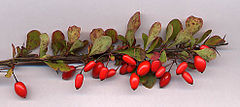Berberis thunbergii
| Berberis thunbergii | |
|---|---|

| |
| Berberis thunbergii shoot with fruit | |
| Scientific classification | |
| Kingdom: | |
| Division: | |
| Class: | |
| Order: | |
| Family: | |
| Genus: | |
| Species: | B. thunbergii
|
| Binomial name | |
| Berberis thunbergii | |
Berberis thunbergii (Japanese barberry or Thunberg's Barberry) is a species of Berberis, native to Japan and eastern Asia.
It is a dense, deciduous, spiny shrub which grows 1-2 (3) m high. It has deeply grooved, brown, spiny branches with a single (occasionally tridentine) spine (actually a highly modified leaf) at each shoot node. The leaves are green to blue-green, very small, spatula to oval shaped, 12-24 mm long and 3-15 mm broad; they are produced in clusters of 2-6 on a dwarf shoot in the axil of each spine. The flowers are pale yellow, 5-8 mm diameter, produced in drooping 1-1.5 cm long umbrella-shaped clusters of 2–5; flowering is from mid spring to early summer. The fruit is a glossy bright red to orange-red, ovoid berry 7-10 mm long and 4-7 mm broad, containing a single seed. They mature during late summer and fall and persist through the winter.
Cultivation and uses
It is widely grown as an ornamental plant, both in Japan and elsewhere in the temperate Northern Hemisphere. Numerous cultivars have been selected, including plants selected for yellow, dark red to violet, or variegated foliage, erect growth (for hedge use), and dwarf size. In recent years it has become an invasive species in parts of the eastern United States; in Canada its cultivation is prohibited as the species can act as a host for Puccinia graminis (black rust), a rust disease of wheat. Currently there are breeding and selection programs aimed at producing cultivars that are either sterile or produce relatively little seed.
It is sometimes confused with Berberis canadensis (American Barberry), Berberis vulgaris (European Barberry), and other deciduous Berberis species; it is most readily distinguished by the flowers being produced in umbels, not racemes.
References
- Flora of North America: Berberis thunbergii (deals with the species as an introduced plant)
- US National Park Service: Berberis thunbergii (deals with the species as an invasive species)
External links
- Berberine Thoughts - Informative but non-scholarly essay on Barberry & Berberis (Culture, History and Etymology... and Thunberg).
-
Cultivar 'Aurea'
-
Cultivar 'Atropurpurea'


